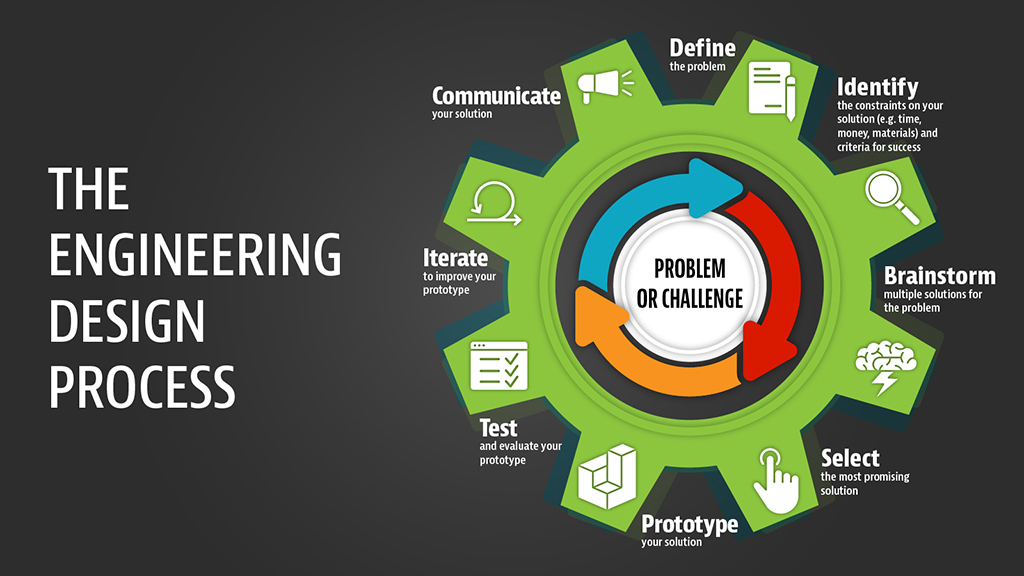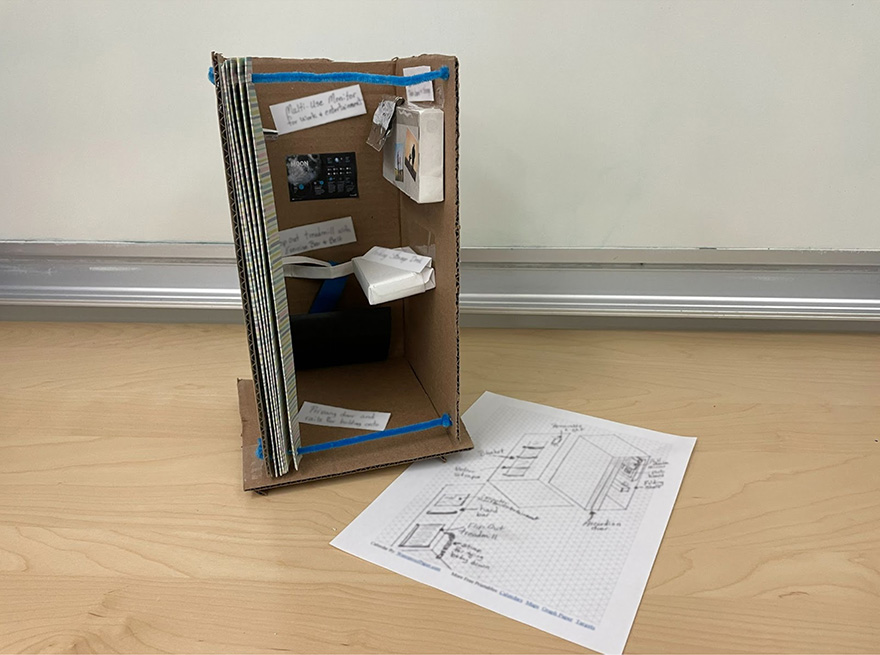Good night HALO!
In this activity, you will design a multi-functioning sleeping compartment for astronauts on the HALO (Habitation and Logistics Outpost).

Text version of infographic entitled "The engineering design process"
The engineering design process
- Problem or challenge
- Define the problem
- Identify the constraints on your solution (e.g. time, money, materials) and criteria for success
- Brainstorm multiple solutions for the problem
- Select the most promising solution
- Prototype your solution
- Test and evaluate your prototype
- Iterate to improve your prototype
- Communicate your solution
Infographic entitled "The engineering design process". (Credit: Canadian Space Agency [CSA])
Define
The Lunar Gateway will orbit the Moon and serve as a stepping stone for future lunar exploration. Unlike the International Space Station, which is about as wide as five hockey rinks, the Lunar Gateway will be much smaller, or about the size of two small school buses. Astronauts will have limited space while stationed at the HALO. The HALO module will be quite small and the astronauts will need to perform experiments, command the Gateway, eat, rest, exercise, etc., while in an area no larger than one small school bus. These sections need to be designed while keeping efficiency and flow in mind. Multi-functional and modular components are essential for maintaining a small footprint in these areas.
Your challenge is to design a multi-functioning sleeping compartment on the HALO.
Learn about Canada's role in the Lunar Gateway!
Suggested materials
- Paper, graph paper, or isometric paper to sketch your design
- Ruler or measuring tape
- Cardboard, wood, or plastic
- Fasteners (binder clips, brads, pipe cleaners, string, tape, glue, or homemade glue)
- Scissors or cardboard cutters
- Hot glue gun (optional)
- Any repurposed materials you have on hand (egg cartons, straws, popsicle sticks, skewers, fabric, branches, twigs, rocks, etc.)
- Variety of paints, coloured paper, tinfoil, or any other available embellishments

Text version of infographic showing a few cardboard cutting and folding techniques
A few cardboard cutting and folding techniques
- Flange
- L-brace
- Tabs
- Slot + cut
- Slot + tab
- String
A few cardboard cutting and folding techniques. (Credit: CSA)
Identify
Constraints – How do astronauts sleep in a microgravity environment? Where do they go to take a break from the other person they have been living closely with? What other purposes can your limited space serve? Can you integrate a simple machine in your prototype here on Earth to simulate an expected behaviour in space and microgravity?
| Number | Item/Object in compartment |
Function 1 | Function 2 | Function 3 | Function 4 |
|---|---|---|---|---|---|
| 1 | - | - | - | - | - |
| 2 | - | - | - | - | - |
| 3 | - | - | - | - | - |
| 4 | - | - | - | - | - |
| 5 | - | - | - | - | - |
| 6 | - | - | - | - | - |
| 7 | - | - | - | - | - |
| 8 | - | - | - | - | - |
Brainstorm
- What is the difference between living on Earth and living in space? Given the function(s) of the compartment you have selected to design, what components do you need to add to your compartment? Remember to support a healthy work-life balance for astronauts and try to think of components that will serve multiple purposes.
- What are some limitations and challenges that you will need to overcome? Given a limited area, how can you optimize the area you have to provide multi-functioning space? How will the lack of gravity in outer space have an effect on your design?
- How does being in space affect sleeping habits?
Select
- What is your most promising solution to be able to fit all of these essentials into your plan?
- Sketch out your main idea on paper, or isometric graph paper. Include a top view and a front view of your compartment with its various components in their specific locations. Will you have access to materials to build your prototype or will you need to overcome these material constraints?

Example of a design sketched out on isometric paper and a model of a sleeping compartment for the HALO. (Credit: CSA)
Prototype
- Gather a variety of recyclable materials.
- Sketch and label your design from different angles on paper or isometric paper.
- Share your design with others and get feedback on your concept and ideas.
- Integrate any feedback that you feel can help improve your design.
- Build a model of your design.
- Add labels to identify the various components that would be housed in that sleeping compartment.
Test
How will your selected compartment and its components fit within the HALO? How is your design conducive to a good work/life balance for the astronaut? How does your compartment balance well with other compartments created? What's missing? What's duplicated? What simple machines were you able to incorporate? Would your design component be more cost-effective to be fabricated on Earth or in space? Why?
Iterate
How could you add another function to further reduce the space used in the Lunar Gateway? How can you ensure your multi-functional components can be portable for use in other compartments? What are some of the limitations when trying to combine feature sets? If you were to redesign your solution, what changes would you implement?
Communicate
Create a how-to video on how your multi-functioning components would work aboard the Lunar Gateway. Share your project on social media and tag the CSA accounts. You never know, a real astronaut or engineer might see your creation! Share with friends and family and ask for feedback.
Taking it further
- Can you find information about what the astronauts will be doing in the HALO?
- Can you research your components or modules and better understand their purpose?
- Enhance your design by incorporating your favourite micro-controller, like the micro:bit, CPX, Arduino, or Raspberry Pi to add lights, sound, sensors, or motors to your component or device.
- Light up your HALO by adding LEDs with a simple circuit, or paper circuit, and a battery.
- Can you develop a product overview video using Green Screen?
- 3D design parts using your favourite CAD software and/or 3D print parts for your component, tool, or device.
- Can you create an interactive experience for your component, tool, or device using Scratch, Unity, or Unreal Engine?
Curriculum links
- Measurement:
- Number sense and standard measurement (cm/mm)
- Square area and volume
- Ratios and proportions
- Sketching, labelling
- Creativity, critical thinking and problem solving, communication and collaboration
- Design thinking and the engineering design process
